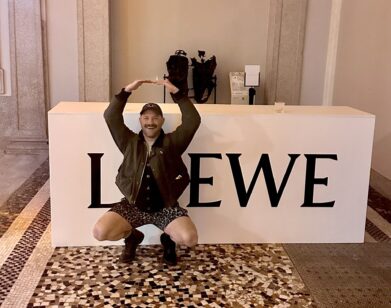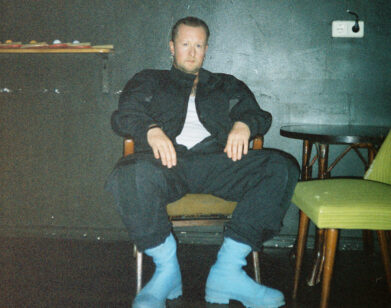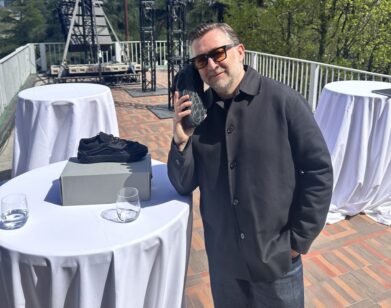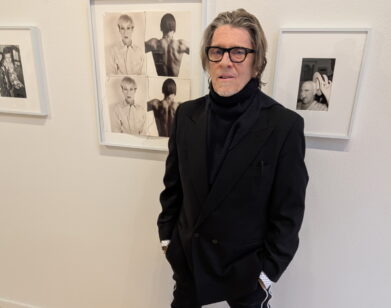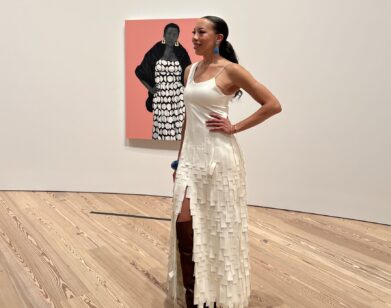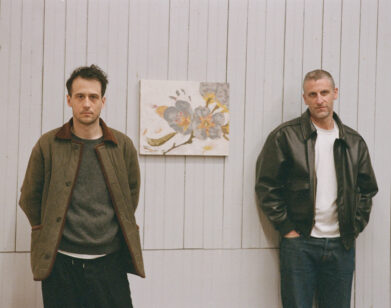The Civilians’ Museum as Musical
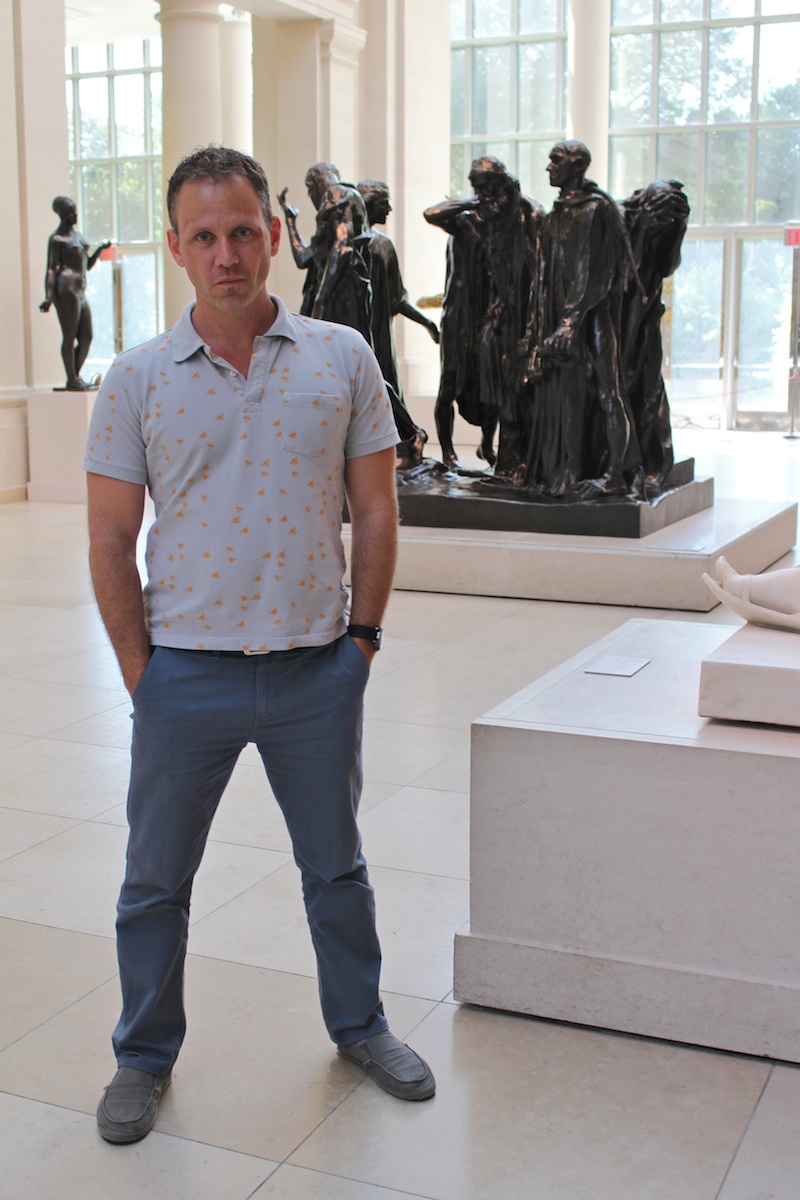
ABOVE: THE CIVILIANS’ STEVE COSSON AT THE MET
The Metropolitan Museum of Art is a venerable New York institution with a global reputation for its immensity. As of 2014, over two million art objects are housed in just as many square feet, split between 17 curatorial departments in two prominent locations (soon to be three). At six years shy of its sesquicentennial anniversary, the Met is still guided by its original charter, opening the doors to its encyclopedic collection for more than six million visitors annually. In becoming a “universal museum,” the Met has spent the first part of the 21st century addressing a unique set of challenges and is tasked with transforming the museum from a static site of art reliquaries into one of active communication.
Propelled by the ambitious and dynamic programming of Limor Tomer, the Met Museum Presents series and Artist in Residence program have been offering more opportunities for contemporary performance art to engage with the permanent collection. In an unprecedented event, The Metropolitan Museum of Art will be partnering with the Civilians, its first theatrical group in residence, to collaborate on a series of several new works throughout the galleries. The Civilians is well known for its innovative and investigative artistic process, relying heavily on interaction and interviews with individuals and communities to create new theatrical work. The company’s work has been presented locally, nationally, and internationally to critical acclaim.
We invited Steve Cosson, Artistic Director and founder of the Civilians, to act as interviewee rather than his usual role as interviewer over a cup of a coffee at the Petrie Court Café in the Met, where he discussed the Civilians’ artistic methodology and upcoming performances at the Met and beyond.
RACHEL EGAN: We first met at an after-party for Let Me Ascertain You: F*cking & Dying at Joe’s Pub. I know that your first event here as Artists in Residence will be another installment in cabaret/podcast series. How will the Met edition compare to past performances?
STEVE COSSON: The inaugural event of our residency will be a combination of some interviews we will be pulling from The Civilians’ archive coupled with new ones we’re currently conducting with Met curators. The format will be fairly similar—a mix of actors performing monologues and songs that are derived from and inspired by the interviews. It will have a very loose and wandering theme somewhat centered on beauty, the body, and desire.
EGAN: How does one go about merging your archives from these past interviews and conversations you’ve had with Met curators to create a cohesive program?
COSSON: I leapt off from the fact that we were going to be creating a stage here in the cafe adjacent to the [Carroll and Milton] Petrie European Sculpture Court. One is really struck by icons of classical beauty in this range of extraordinary sculptures. After considering the space, the next step was thinking about the various projects we’ve done and the kind of content we already have. For example, we have a whole set of interviews we did with women inside Bogotá’s El Buen Pastor Women’s Prison leading up to their annual beauty pageant. One of the pieces [in Let Me Ascertain You] is from this set in Bogotá with the winning inmate. It’s her story of victory, beauty, and the pageant’s personal significance. We also plan to include parts from our new musical Pretty Filthy, premiering this January at the Abrons Art Center in New York. It has been in development for years and is inspired by interviews and research with adult entertainers in Los Angeles and the San Fernando Valley. That industry has a very different angle on representing the body with beauty and desire performed in a heterogeneous context. Part of what I love about the cabaret format is its inherent eclecticism—all of these contrasting yet equally valid points of view sharing the same stage, sequenced together into a unique experience for the public. It’s a collage form. The audience then gets to connect the dots through their own associations of listening and watching.
EGAN: How did you get involved with this residency? I know that there have been two residences before this—this is a new kind of initiative. There was D.J. Spooky and then there was The Alarm Will Sound and now The Civilians.
COSSON: It started at the invitation of Limor Tomer. She wasn’t familiar with the work of The Civilians when we first met. I gave her an overview of what we do, she attended a couple of shows of ours, including a Let Me Ascertain You at Joe’s Pub. We each initially had some get-to-know-you conversations, and a few people had directed her in our direction. When we first met, she wasn’t familiar with the work of The Civilians. Her background is more in music. I think she had put out some feelers, to get ideas for theater or other companies. We gave her an overview of what we do, and then she attended a couple shows of ours, including a Let Me Ascertain You at Joe’s Pub and The Great Immensity at The Public Theater. The development of the residency was very collaborative. She explained to me that the mandate in her programming is to tease out the many different stories and narratives that are embedded here within the extraordinary collection within the Met Museum. She then tasked me to accomplish that through the approach of The Civilians. I came back to her with a proposal of several different projects, which we narrowed it down to Let Me Ascertain You in the Petrie Court Café, The End and the Beginning in the Temple of Dendur [in the Sackler Wing], and a wholly original show inspired by work in the American Wing.
EGAN: What is it like interviewing curators at the Met compared to other people that you’ve interviewed for other projects? How do you utilize interview format as both qualitative research and theatrical tool?
COSSON: So far, I’ve only interviewed one curator. I have the experience of one, but I imagine certain things about that conversation would be consistent. The first thing is that curators are a people who have to be articulate about the work that they do. I would class a curator in the “expert” category. Experts have extensive knowledge about a particular skill or experience, and most can easily talk about that part of their life. We’ve done many interviews with all kinds of experts and in a certain way, it’s easy with them—you just push record and they’ll go off about their specialty. Art history is not my background, so when interviewing the Met curators, I try to ask the sorts of questions that I think all of our audience would be asking if they had the opportunity to do so.
I think part of why I love these kinds of conversations is that the interviewer will always learn something new from the interviewee. It opens up your mind to new ideas and the vast multiplicity of human experience. In conducting interviews, my fascination is not only with the content of the conversation, but also the overall delivery of spoken language—so much of one’s personality and story is embedded within their speech, their rhythms, the structure of their thoughts, their use of particular diction or dialect. While speaking with a curator in the Department of Medieval Art, I was aware that I was receiving the authoritative history of the artwork through a living, breathing conduit in the present. It actually is a triangular conversation between the curator, the art, and myself. I’m really interested in the reciprocal dynamics of that triangle, as much as I’m interested in the content of the conversation itself.
EGAN: I realize some of the questions that I’m asking are a little preemptive because the residency has only just begun. Are you hoping to interview any of the visitors or staff? The guards?
COSSON: We’ll be doing some new interviews with the staff of the Department of Egyptian Art when we start work on The End and the Beginning. I anticipate that large percentage of the content for our final show will come from on-site interviews of visitors to the galleries of the American Wing.
EGAN: The Met has over six million visitors per year. That’s quite an inundation of stories.
COSSON: From all over the world! I’m really excited at discovering what happens when people from different backgrounds take in this work within the American Wing. I’m fitting it into my own knowledge, for better or worse, of American history. I imagine that all Americans have a unique relationship in their individual present to their collective past and how that relationship might shape their identities and experiences. Likewise with international visitors—perhaps even more so.
There is a course of fixed material reality to a work within a museum—be it a sculpture, painting, or decorative object—along with its “definitive” scholarship. I hope to highlight and explore the additional dimension of an interactive social context with the collection. The best way I can picture this is like a small cloud of stories centered on a physical object. The cloud itself is beautiful, dynamic, and mutable, daily changing its shape with each visitor’s subjective experience. I’m hoping to discover our show in that cloud.
EGAN: Do you have a memory of coming to the Met for the first time?
COSSON: I have a terrible memory in general, so I don’t remember when I came to the Met for the first time. I do know what room I visited, though.
EGAN: Which room?
COSSON: It’s a wing in the round.
EGAN: The Robert Lehman Collection? It’s all the way in the back of the museum and has always been my favorite part of the Met.
COSSON: That sounds right. I believe there were a bunch of Blake prints on display. I don’t know how I got there. It may have been that Patti Smith had done a reading. Because Patti likes Blake.
EGAN: And Patti likes the Met.
COSSON: And I like Patti. And I like Blake. I think I couldn’t actually see her Blake reading, so I figured I could at least see the exhibition. There’s a lot of the museum that I’ve still not carefully seen. While I’ve visited most of the galleries, I feel like I could easily have a two-month residency where I did nothing but come to the Met every day and really look at the collection.
EGAN: Some New Yorkers actually do that. That’s the nice thing about a membership or being able to pay what you wish. When I worked for Visitor Services, I do remember certain people coming in every few days—possibly even every day for some. I’ve come to think of them as guardians of the Met.
COSSON: When I first met Limor, she told me that her husband taught her how to “go to the Met.” She would feel completely overwhelmed by the sheer scale and sensory overload.
EGAN: Me too! I’m convinced Stendhal syndrome is a legitimate disorder—I cry every time I go to the Uffizi.
COSSON: Limor’s husband said that one should visit the Met already knowing what they’re going there to see. You divide and conquer—visiting one work, one room, or one exhibition, taking the all the time you might need with that experience, then promptly leaving. You repeat, picking a new area, and so on. Obviously this doesn’t work very well if you’re a tourist, but for a New Yorker this struck me as a great way to get to know the collection. Personally, though, I love wandering. It’s liberating to throw away the map and explore uncharted galleries. You’ll nearly always stumble into something immensely interesting that way.
THE CIVILIANS KICKS OFF ITS RESIDENCY AT THE METROPOLITAN ART ON SEPTEMBER 12 AND 13 AT 7 PM WITH A SPECIAL PRESENTATION OF LET ME ASCERTAIN YOU. FOR TICKETS AND MORE INFORMATION, PLEASE CLICK HERE.

